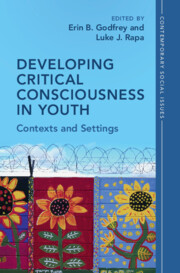Book contents
- Developing Critical Consciousness in Youth
- Contemporary Social Issues Series
- Developing Critical Consciousness in Youth
- Copyright page
- Dedication
- Contents
- Figures
- Tables
- Contributors
- Acknowledgments
- Introduction
- Part I Pedagogical, Curricular, and School-Based Contexts
- Part II Extracurricular Contexts
- Part III Societal Contexts
- 7 Critical Race Consciousness
- 8 The Quest for Racial Justice
- 9 Critical Consciousness Development among Undocumented Youth
- 10 Influences of Sense of Social Responsibility, Immigrant Bargain, and Immigrant Optimism on Critical Consciousness Development among Immigrant Youth of Color
- Concluding Thoughts on the Role of Contexts and Settings in Youth Critical Consciousness Development
- Index
- References
10 - Influences of Sense of Social Responsibility, Immigrant Bargain, and Immigrant Optimism on Critical Consciousness Development among Immigrant Youth of Color
from Part III - Societal Contexts
Published online by Cambridge University Press: 11 May 2023
- Developing Critical Consciousness in Youth
- Contemporary Social Issues Series
- Developing Critical Consciousness in Youth
- Copyright page
- Dedication
- Contents
- Figures
- Tables
- Contributors
- Acknowledgments
- Introduction
- Part I Pedagogical, Curricular, and School-Based Contexts
- Part II Extracurricular Contexts
- Part III Societal Contexts
- 7 Critical Race Consciousness
- 8 The Quest for Racial Justice
- 9 Critical Consciousness Development among Undocumented Youth
- 10 Influences of Sense of Social Responsibility, Immigrant Bargain, and Immigrant Optimism on Critical Consciousness Development among Immigrant Youth of Color
- Concluding Thoughts on the Role of Contexts and Settings in Youth Critical Consciousness Development
- Index
- References
Summary
Critical consciousness theory suggests that engaging in social change behaviors is particularly important for the positive development and empowerment of youth of color. This literature has paid little attention to potential variations in critical consciousness development among youth of color with immigrant backgrounds. This chapter represents an effort to integrate acculturation and critical consciousness literatures to advance theory and improve our understanding of what promotes or hinders the critical consciousness development and liberation of immigrant youth of color. A focus of this chapter is on youths’ sense of social responsibility, or sense of duty to the systems within which they are embedded. We explore ways in which this sense of responsibility influences and is influenced by immigration phenomena, such as the immigrant bargain and the immigrant optimism hypothesis, which first emerge within families and might later transfer to more distal systems. We offer recommendations for further integration of these literatures.
Keywords
- Type
- Chapter
- Information
- Developing Critical Consciousness in YouthContexts and Settings, pp. 292 - 317Publisher: Cambridge University PressPrint publication year: 2023



